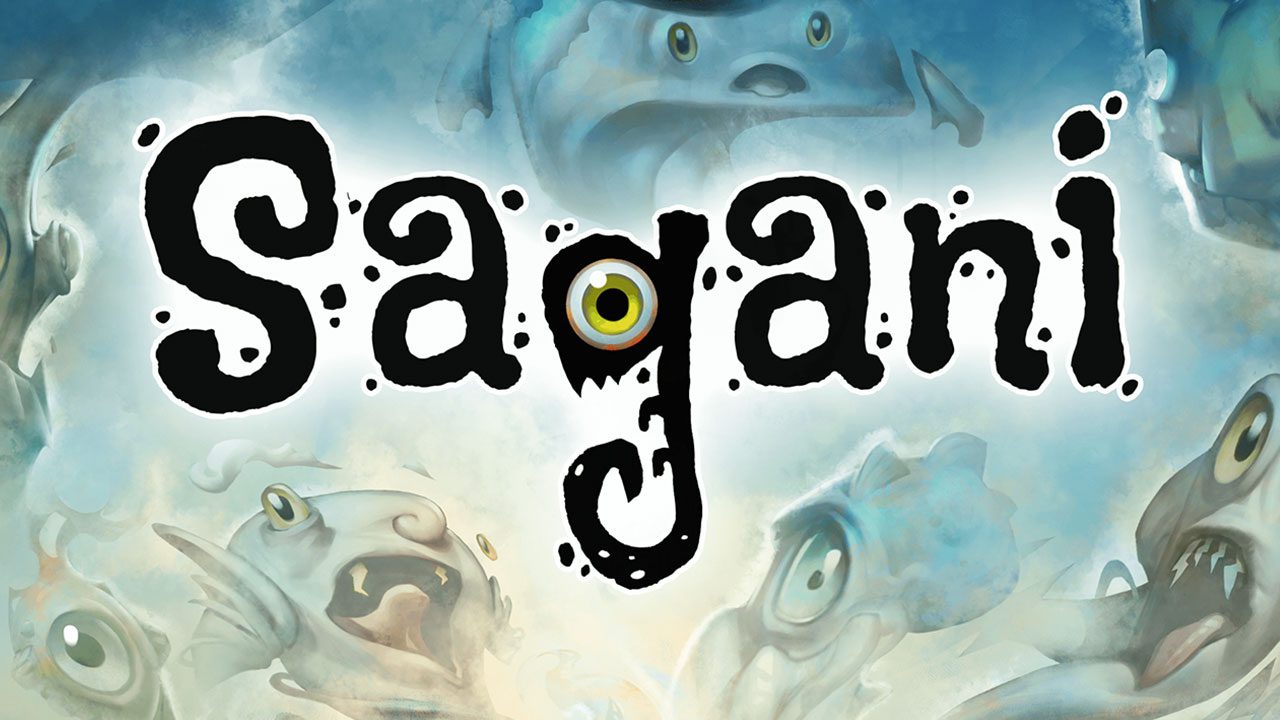Disclosure: Meeple Mountain received a free copy of this product in exchange for an honest, unbiased review. This review is not intended to be an endorsement.
In 1493 in the unassuming Swiss village of Egg, a boy was born whose parents wasted no time in bestowing upon him the easy to remember moniker Philippus Aureolus Theophrastus Bombastus von Hohenheim. History, however, remembers him by the much more difficult to remember pseudonym of Paracelsus. A physician, an alchemist, a lay theologian, and a philosopher, Paracelsus had a lot of thoughts and ideas about a wide range of subjects. And thanks to the efforts of various scribes at the time, we have the ability to explore those concepts today.
One of the subjects he elaborated upon was the concept of nymphs, sylphs, pygmies, and salamanders: four races of creatures living here with us, invisible to the human eye, each closely associated with one of the four elements – earth, water, air, and fire. These elementals, as they would later come to be known, he referred to collectively as “sagani”.
You might recognize that word as being the name of this game.
In the game of Sagani you are trying to coax these elemental creatures out of their hiding spots so that they can be revealed in their full glory. In order to do this, you must create the harmony necessary to maintain nature’s delicate balance. Each element influences, and is influenced by, the others.
I will be the first to admit that, like many games of its ilk, Sagani’s story is a little threadbare and largely unimportant to the game play.
Sagani works like this…
Setup
There are 72 Spirit of Nature tiles. These are shuffled together and placed into 3 same size stacks so that the image of the elemental and its associated victory point total is face up. The game board is set next to this with room for tiles to sit along its top border. Then 5 tiles are drawn and placed in a row with the symbol side face up.
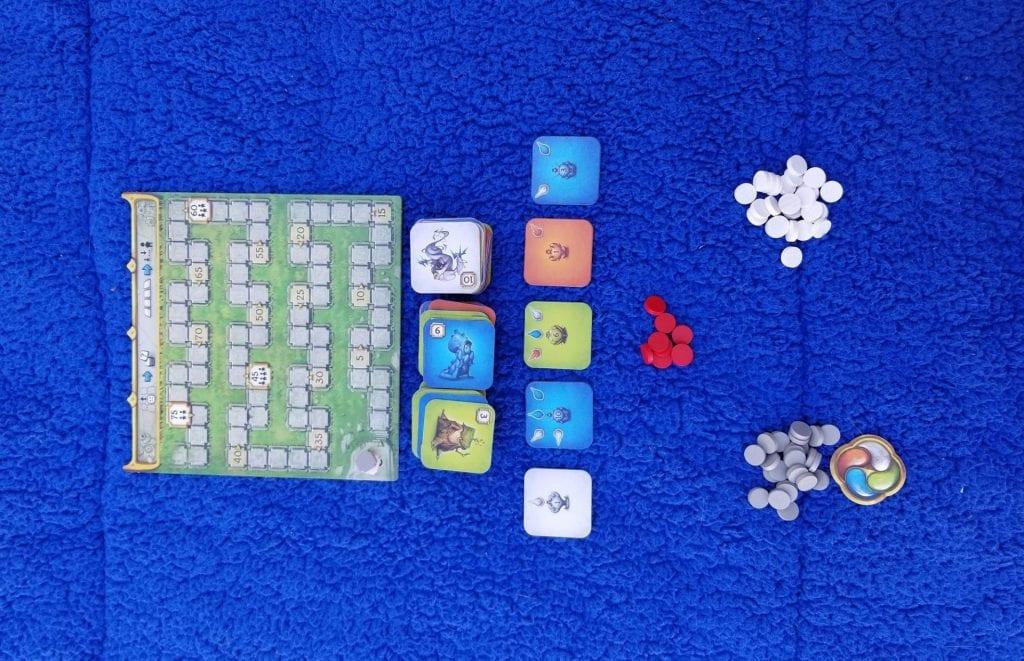
Each player selects a color and receives the Sounds discs of that color. Their scoring marker is placed onto the 0 space of the Harmony (score) track. The red Cacophony discs are kept close by in a general supply. Finally, a starting player is selected, given the Start Player marker, and you’re ready to begin.
Harmony & Discord
The actual gameplay for Sagani is rather simple: select one of the face up tiles and place it into your tableau. It’s the actual placement where things get a little more… complicated. Firstly, each tile placed must be placed orthogonally adjacent to an already placed tile. More importantly, every tile has a unique color and every tile contains a series of different colored icons along its edges. The player will place a number of their Sounds discs equal to the number of these icons in a stack in the center of the tile. If the player does not have enough Sounds discs left in their supply, they must use Cacophony discs to cover the shortage. Each of these will cost that player 2 victory points immediately. But it’s not all bad. If the tile is ever cleared, the player gets to keep these discs to use on later turns.
Each icon has a unique color and is shaped like an arrow pointing in a cardinal direction. If the player places a tile in a later turn that’s in that cardinal direction and matches the icon’s color, then one of the Sound discs is removed from the center of the tile on which the icon appears and covers the icon.
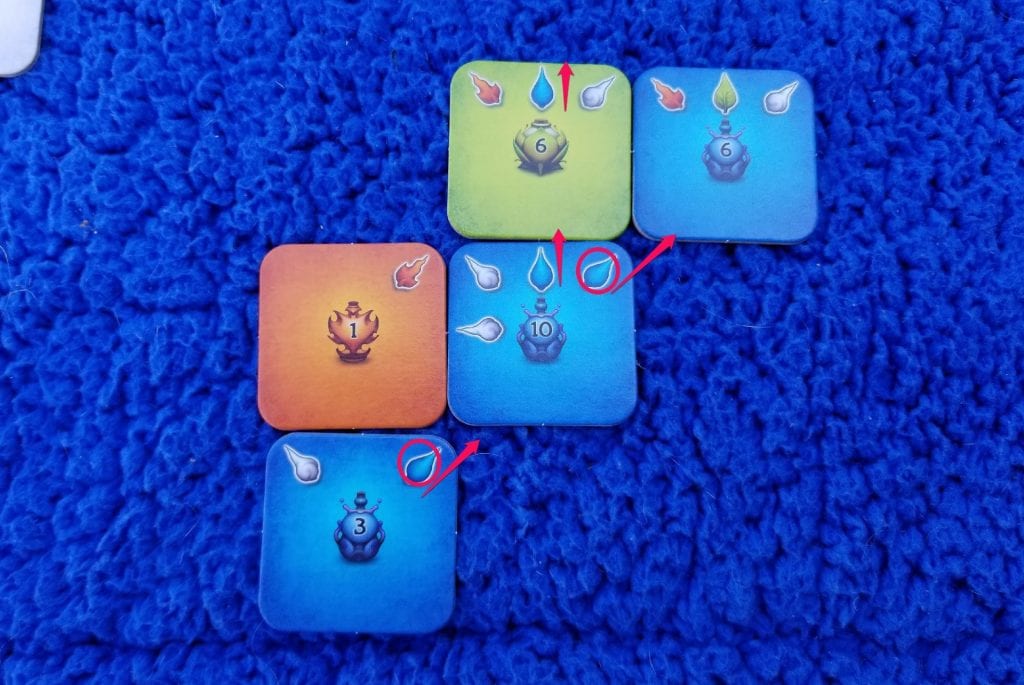
If all of the icons on a tile ever get covered, the Sounds discs are removed, the tile is flipped over, and it scores the player the number of points indicated.
One note of import here: each player is constructing their own tableau. And this brings me to my first negative. Sagani is a table hog. It wouldn’t seem that a game composed mostly of small, square tiles would be so imposing, but the unfettered, unbordered sprawl quickly proves otherwise. It’s like a game of Carcassonne multiplied by the number of people that are playing. So be forewarned: if you’re going to play Sagani, you’re going to need plenty of room.
The Intermezzo
At some point during a round of Sagani, there is going to be a single tile left in the display for a player to select from. That player has a choice: take the tile and place it into their tableau or place the tile into the Intermezzo row along the top of the game board and draw the next tile from the stack. (This tile must be placed in their tableau). Even though these tiles only display their victory points, they do provide a few pieces of information: their color as well as how many icons are going to appear on the other side (1 point = 1 icon, 3 points = 2, 6 points = 3, and 10 points = 4) so the players are never drawing completely blind. If the fourth position on the Intermezzo row is ever filled, an intermezzo is triggered.
“Intermezzo”, if you are not aware, is a musical term that describes a short connecting instrumental movement in an opera or other musical work or a light dramatic, musical, or other performance inserted between the acts of a play. Much like its musical counterpart, the intermezzo in Sagani is a pause in the flow of the game to attend to some side business before returning to the business at hand.
During an intermezzo, the player who is the farthest behind on the Harmony track has the option to choose any of the 4 tiles to place into their tableau. Then the next person has the same option, followed by the next, and so forth until everyone has either taken a tile or passed. If everyone opted to pass, the Intermezzo row is cleared and the tiles there are removed from the game. Then 5 more tiles are drawn and placed into a row beside the game board and play continues as normal from whoever’s turn is next.
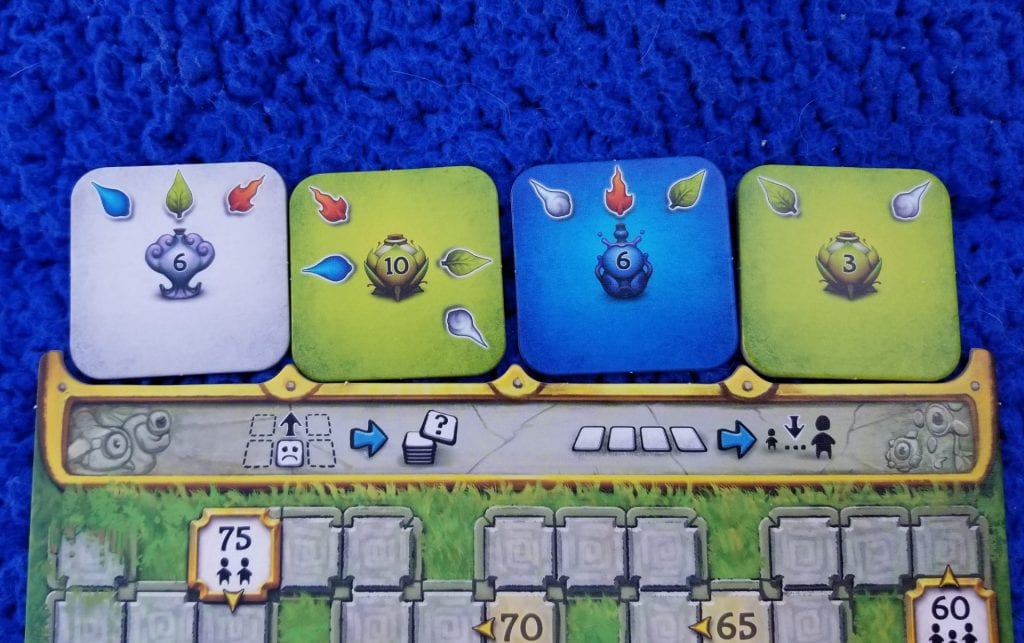
This whole intermezzo business brings me to my second, third, and fourth complaints. First, nowhere in the rules is there any order imposed on which stacks you draw tiles from when it comes time to draw them. This means that the person that’s drawing and placing tiles for the next round can conceivably “stack the deck” in their favor by purposefully trying to place out tiles whose colors match their uncovered icons. After playing one game and realizing that these types of shenanigans could occur (and most likely had), I decided then and there that I would dictate that you cannot draw from one stack until the previous one had been exhausted.
Second, the activity during the intermezzo can be really confusing as each person takes turns picking up each of the tiles and twisting and turning them to try to fit them into their display in some way that is beneficial. By the time each person has finished making their selection, it’s sometimes hard to remember who even triggered the intermezzo in the first place, much less which player should be going next. Sagani really needs a physical token of some sort to keep track of this. I had some extra dice laying around, so I just tossed one into the box. It serves a dual purpose not only as a physical reminder of whose turn it is, but also as a way of determining who the start player will be.
Lastly, the theme really starts to fall flat very quickly. Harmony. Cacophony. Intermezzo. These are all sound-related terms. I’m not sure what any of these have to do with what we’re doing as players. Are we sitting around in a forest clearing playing instruments? Why does that have anything to do with the elemental forest spirits? How is that translated into the game play? I’m trying to move discs around, but it never feels like I’m making a bunch of noise because that noise element, if it’s even meant to be there, is never really represented in the game in a way that makes any sense. Want to see a game that does a good job of representing cacophony? Look no further than Clank! But certainly don’t look at Sagani.
Susurrus
While my previous criticisms may have seemed sharp and biting, not everything is bleak down here on the forest floor. In fact, it’s quite the polar opposite. Sagani is a beautiful game both in its appearance and its gameplay and the aforementioned issues are really minor annoyances at best.
During my first playthrough of Sagani, I was struck by how Nova Luna’s DNA runs throughout the entire game. It isn’t hard to see how, like the elements in Sagani, one has influenced (and, no doubt, been influenced by) the other. These are two games that are cut from the same cloth and I mean that in an almost literal sense in addition to the figurative. While one game is a tile placement game that’s all about placing all of your discs onto the tiles as quickly as possible, the other is a tile placement game that’s just the opposite. If you’ve ever played Nova Luna and then play Sagani, it’s like getting a glimpse into the mind of a game design master. You can almost envision Uwe Rosenberg playing one game while contemplating what the reverse would be like before going on to create it. This is something anyone familiar with Uwe Rosenberg’s work is no doubt well aware of. He has a knack for taking a single concept and just running absolutely wild with it. And I love him for it. Sagani certainly hasn’t dissuaded me from being a huge fan.
Another checkmark in Sagani’s favor is the excellent artwork by Lukas Siegmon. Even though there’s not a lot of it, it’s all done very well. His usage of bold colors gives the game vibrancy and life. Also, I really appreciate that there are different illustrations for each different point value creature. For instance the lowly 1 point blue elemental looks scrawny and breakable when compared to its 10 point brethren. It’s a small touch, but it keeps things looking fresh unlike the game Space Explorers which features amazing artwork that it just rehashes mercilessly.
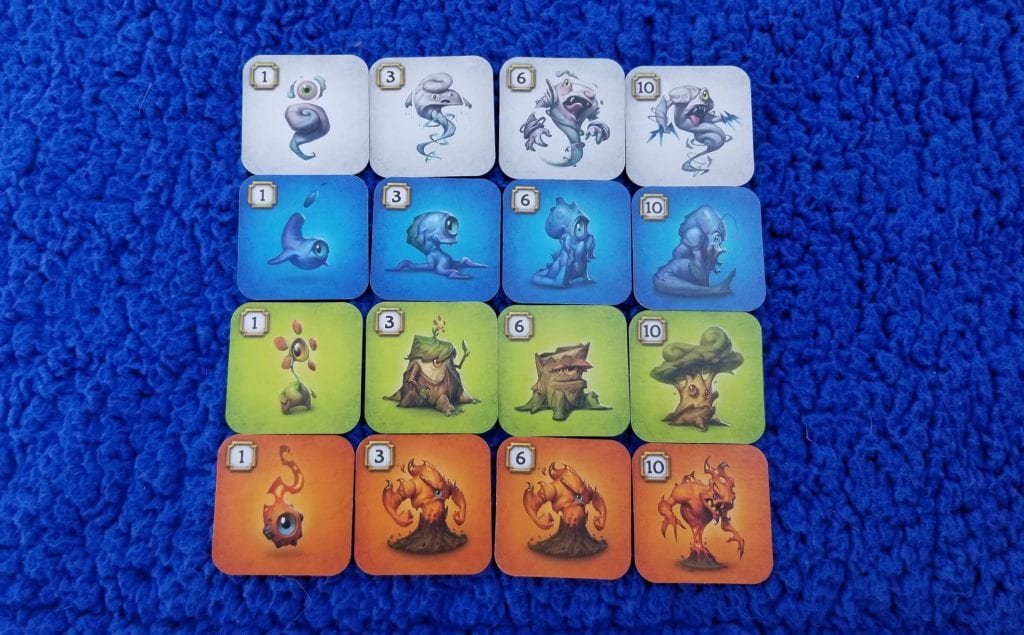
More than anything, though, I really enjoy the way that Sagani makes my brain feel when I’m playing it. There are some games you’ll play where the complexity comes from the intricate mechanics or a complicated rules system. Sagani manages to feel complex despite having neither. It’s a spatial puzzle that requires you to anticipate what might be coming up next. Sometimes you simply have no idea what to expect or you’ll be stuck with an option that isn’t great and you’re tasked with trying to figure out how to make that work for you in the long run. It’s a game that asks you to plan ahead without knowing exactly what you’re planning for. Resident video reviewer Brody Sheard wasn’t wrong when he said in his review that you’ll be putting your thinking cap on. You will. And chances are you’re going to far exceed the time estimate listed on the side of the box doing so.
Don’t let the size of the box or the cartoony appearance of the tiles or the simple rules set fool you. Sagani is not a game for the faint of heart. It’s a game that will constantly challenge you at every turn. But it’s so worth it. Even if the story makes absolutely no sense.


